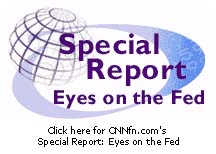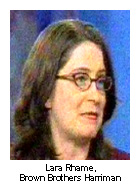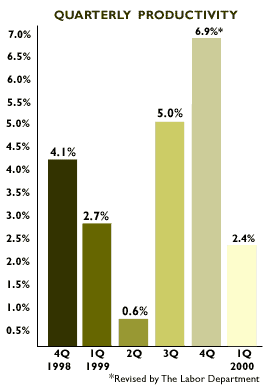|
Fed goes a half point
|
 |
May 16, 2000: 2:15 p.m. ET
Increases benchmark fed funds rate to 6.5%, sees more inflation risks
By Staff Writer M. Corey Goldman
|
NEW YORK (CNNfn) - The Federal Reserve Tuesday raised short-term interest rates by a half percentage point -- the first move of that magnitude in more than five years -- in an effort to slow the torrid pace of the U.S. economy and ensure prices for goods and services don't flare out of control.
 It also gave an onerous hint that it will implement more rate increases in the months to come if need be to ensure the now-record economic expansion continues forward without stumbling. It also gave an onerous hint that it will implement more rate increases in the months to come if need be to ensure the now-record economic expansion continues forward without stumbling.
As expected, the Fed's policy-making arm, the Federal Open Market Committee, raised its influential fed funds target for overnight loans between banks to 6.5 percent, the highest level since January 1991. It also raised the discount rate -- the rate at which the Fed's 12 district banks lend directly to financial institutions -- to 6 percent, the highest level since August 1991.
The increase was the first time since February 1995 that Fed officials opted to lift rates by more than a quarter point, and marked the sixth time in the past 11 months that the Fed has raised rates to cool growth. Most analysts had anticipated a half-point move at the conclusion of Tuesday's meeting.
A stern dose of medicine
For consumers, the rate increase means interest payments on their credit cards and lines of credit are once again going up. The Fed hopes such increases will make consumers think twice about charging that expensive meal or buying that new notebook computer. The same goes for companies, which will be paying a little more to borrow money to finance their ventures.
 Indeed, some of the country's major financial institutions immediately announced a half-point increase in their prime lending rates -- the rate they charge their best customers to borrow. Bank of America (BAC: Research, Estimates) led the pack, lifting its prime rate to 9.5 percent from 9 percent effective Wednesday. Bank One (ONE: Research, Estimates) quickly followed suit with the same announcement. Indeed, some of the country's major financial institutions immediately announced a half-point increase in their prime lending rates -- the rate they charge their best customers to borrow. Bank of America (BAC: Research, Estimates) led the pack, lifting its prime rate to 9.5 percent from 9 percent effective Wednesday. Bank One (ONE: Research, Estimates) quickly followed suit with the same announcement.
"It's not so much current inflation where the Fed sees risks as it is the risk of higher inflation down the road," said Doug Porter, a senior economist with brokerage Nesbitt Burns Inc. "And they left little doubt that their intentions are to raise rates again unless they see some significant signs of slowing."
In the usual, briefly worded statement that the central bank releases with its rate changes, the FOMC said that "increases in demand have remained in excess of even the rapid pace of productivity-driven gains in potential supply, exerting continued pressure on resources." That, they said, could foster inflationary imbalances that would undermine the economy's expansion.
Market retrace
Stocks retreated from earlier highs immediately following the announcement, with the Dow Jones industrial average and the Nasdaq Composite giving back almost half of their gains. By the end of the trading day, however, stocks on both indexes had rallied back into triple-digit territory on optimism that the Fed will remain vigilant at keeping inflation subdued. Bonds registered a mixed performance, with short-term securities more sensitive to changes in official rates turning into negative territory and long-term issues posting gains.
Main Street also greeted the Fed's rate action with enthusiasm. Some 57 percent of readers who took a CNNfn.com flash poll immediately following the Fed's rate decision indicated they agreed with the Fed's move to raise rates. At the same time, about 65 percent of those who took the survey indicated that higher rates will not deter them from spending, either.
 Lara Rhame, an economist with Brown Brothers Harriman, told CNNfn that the Fed's choice of words could have been even more stringent about inflation. Instead, she said, they chose to mute their perception about the risk of accelerating prices going forward. (222KB WAV) (222KB AIFF) Lara Rhame, an economist with Brown Brothers Harriman, told CNNfn that the Fed's choice of words could have been even more stringent about inflation. Instead, she said, they chose to mute their perception about the risk of accelerating prices going forward. (222KB WAV) (222KB AIFF)
What has confused Main Street since the Fed began its series of rate increases last June is why the central bank continues to raise rates at a time when the economy is in its heyday of growth, and when inflation -- with the exception of rising energy prices -- remains almost a complete no-show.
Indeed, with the exception of energy costs, which in recent weeks have begun to retrace their steps upward, prices for items such as computers, wireless phones, DVD players and other goods have actually declined. Higher productivity and fierce competition have kept retailers from raising prices while still improving profit margins -- a mix that Wall Street likes.
A growing imbalance?
What concerns Fed officials is that that mix may be starting to end. The sizzling U.S. job market has spurred employers to start doling out higher wages and benefits to workers to keep them from leaving. And those workers, armed with bigger paychecks and pleased with the gains they've made investing in stocks and real estate, have continued to spend in the face of rising rates -- something that has begun to give some retailers the green light to begin lifting prices.
 Even so, overall inflation still remains remarkably subdued. The Labor Department reported Tuesday that consumer prices were unchanged last month after posting a larger-than-expected 0.7 percent jump a month before. Year-over-year, CPI rose 3 percent in April, higher than in the past, though still significantly below the double-digit inflation rates of the early 1970s and early 1980s. Even so, overall inflation still remains remarkably subdued. The Labor Department reported Tuesday that consumer prices were unchanged last month after posting a larger-than-expected 0.7 percent jump a month before. Year-over-year, CPI rose 3 percent in April, higher than in the past, though still significantly below the double-digit inflation rates of the early 1970s and early 1980s.
John Ryding, senior economist with Bear Stearns, told CNNfn that if the Fed opts to raise short-term rates again at its June 27-28 policy meeting, even by just a quarter point, that they may risk derailing the 110-month-long economic expansion by making it too expensive for consumers and businesses to borrow. (349KB WAV) (349KB AIFF)
So far, financial markets are anticipating the Fed will do just that. The June fed funds futures contract -- which indicates where investors are betting the fed funds rate will be by the end of June -- currently has an implied yield of 6.525 percent, while the July fed funds futures contract has an implied yield of 6.775 percent, indicating investors are pricing in another quarter-point rate increase from the Fed by their next meeting.
Still lots of productivity
Part of the reason inflation has remained so low is because of worker productivity -- where technology, automation, and other high-tech factors have made workers more efficient, thus allowing companies to keep their costs in check by squeezing more output from their workers. Productivity increased at a 6.4 percent annual rate in the fourth quarter -- the fastest pace in seven years -- and tapered off to 2.4 percent in the first three months of 2000.
 And for all the fears of inflation, price increases have remained relatively modest by historical standards. The emergence of the Internet as a means for buying and selling, competition from suppliers abroad and the emergence of a cost-savvy and service-hungry culture have all combined to make it difficult for corporations to raise their prices. And for all the fears of inflation, price increases have remained relatively modest by historical standards. The emergence of the Internet as a means for buying and selling, competition from suppliers abroad and the emergence of a cost-savvy and service-hungry culture have all combined to make it difficult for corporations to raise their prices.
On the flip side, after an unprecedented nine years of economic expansion, the trend toward higher prices does, in fact, make some sense. With incomes and overall wealth on the rise, consumers are simply more willing to shell over more cash for everything from movie tickets to new cars to appliances and vacations.
As usual, the Clinton administration stuck by its policy of not commenting directly on the Fed's actions and said it respected the Fed's independence.
"The Fed will do its job and we will do ours, and I'm going to let them make whatever decision that Chairman Greenspan and the others think is warranted," President Clinton said. 
|
|
|
|
|
|
U.S. Federal Reserve
|
Note: Pages will open in a new browser window
External sites are not endorsed by CNNmoney
|
|
|
|
 |

|

